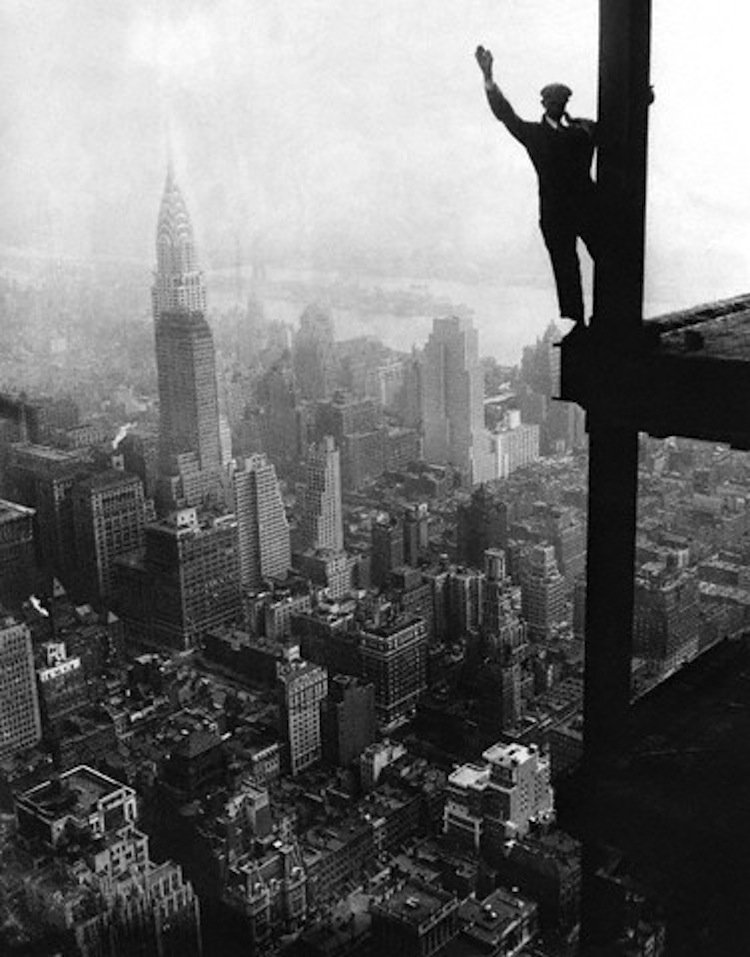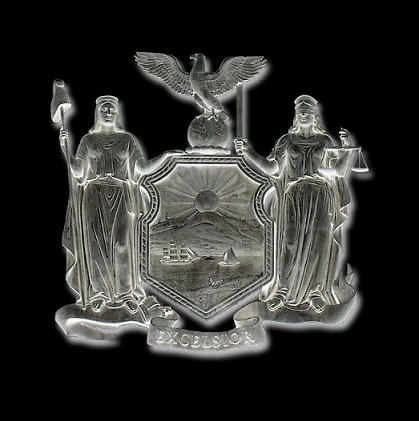New York - MCMXXX
- CoC -HPL- New York City
Contents
- 1 Quote
- 2 Appearance
- 3 City Device
- 4 Climate
- 5 Demonym
- 6 Economy
- 7 Geography
- 7.1 MANHATTAN: UPTOWN
- 7.1.1 WASHINGTON HEIGHTS
- 7.1.2 Columbia Presbyterian Medical Center, Broadway Ave. from 165th St. to 168th St.
- 7.1.3 American Geographic Society, Broadway & 155th St.
- 7.1.4 Trinity Church Cemetery and Mausoleum, Amsterdam Ave. & 153rd St.
- 7.1.5 College of the City of New York, Amsterdam Ave. from 136th to 140th St.
- 7.1.6
- 7.1.7
- 7.1.8
- 7.1.9
- 7.1.10 Central Park
- 7.1.11 UPPER PIFTH, MADISON AND PARK AVENUE DISTRICT
- 7.2 MANHATTAN: MIDTOWN
- 7.3 MANHATTAN: DOWNTOWN
- 7.4 THE OUTER BOROUGHS
- 7.1 MANHATTAN: UPTOWN
- 8 History
- 9 Population
- 10 Arenas
- 11 Attractions
- 12 Bars and Clubs
- 13 Barbership
- 14 Cemeteries
- 15 City Government
- 16 Crime & Punishment
- 17 Citizens of the City
- 18 Communications
- 19 Current Events
- 20 Fortifications
- 21 Galleries
- 22 Holy Ground
- 23 Hospitals
- 24 Hotels & Flop Houses
- 25 Investigators
- 26 Landmarks
- 27 Mass Media
- 28 Monuments
- 29 Museums
- 30 Parks
- 31 Private Residences
- 32 Restaurants
- 33 Ruins
- 34 Schools
- 35 Secret Societies
- 36 Shopping
- 37 Theaters
- 38 Transportation
- 39 Unfathomable Horrors
- 40 Errata
- 41 Websites
Quote
“New York is a great secret, not only to those who have never seen it,"
“but to the majority of its own citizens. Few living in the great city"
“have any idea of the terrible romance and the hard reality of the lives"
“of two-thirds of the inhabitants. . . . No matter how clever a man may be"
“in his own town or city, he is a child in the hands of the sharpers and"
“villains of this community, and his only safety lies in avoiding them. His"
“curiosity can be satisfied in these pages, and he can know the Great City"
“from them, without incurring the danger attending an effort to see.”
- Edward Winslow Martin, The Secrets of the Great City
Appearance
City Device
Climate
Demonym
Economy
Geography
“Bronx is up and the Battery is down,”
MANHATTAN: UPTOWN
"[Is] New York the most beautiful city in the world? It is not far from it. No urban nights are like the nights there. I have looked down across the city from high windows. It is then that the great buildings lose reality and take on magical powers. Squares and squares of flame, set and cut into the ether. Here is our poetry, for we have pulled down the stars to our will." -- Ezra Pound
WASHINGTON HEIGHTS
Like the nearby Morningside Heights, this district has
many prominent institutions forming man-made
canyons along the avenues and streets. Row houses also
edge the streets, though many are being demolished in
the twenties and replaced with apartments for the city's
growing number of middle-class professionals.
Columbia Presbyterian Medical Center, Broadway Ave. from 165th St. to 168th St.
Opened to the public in October of 1928, the Columbia
Presbyterian Medical Center spans nearly twenty acres,
making this the largest collection of medical and
research facilities in the United States through the end
of the 1930's. The buildings are typical of many
institutional designs of the 1920's, cold and efficient. The
Columbia Presbyterian Medical Center is a collective of
Columbia University College, Presbyterian Hospital
Group, Sloane Hospital for Women, Babies Hospital for
the City of New York, and the Neurological Institute.
Also found at this location is the New York State Psychiatric
Institute and Hospital, though it is not affiliated
with the other four corporate groups in the medical
center. Until the later establishment of a psychiatric
wing at Bellevue, this is one of the better public locations
for treatment of psychiatric disorders. Unlike the
Manhattan State Hospital for the Insane on Ward's
Island, this facility is not overcrowded and antiquated.
American Geographic Society, Broadway & 155th St.
Dedicated to exploration, discovery and research, the
American Geographical Society is a useful resource for
investigators. The Society, founded in 1852, is respected
and esteemed by many influential members of the New
York City aristocracy. While the Society's extensive
library and map collection are open to the public, many
prominent members of the AGS will not tolerate investigators
ranting about strange forgotten races, or engaging in
research that could sully the honored reputation
of the Society. This means investigators must keep the
true nature of their work a secret from all but the most
opened minded of AGS members. The Society provides
funding for expeditions and research projects of merit
that promise to expand the sciences.
Fellows of the American Geographic Society hold
meetings twice monthly. A donation is required to
become a member requires of the AGS.
- Hubert Broughton -- Prominent Fellow of the AGS
Trinity Church Cemetery and Mausoleum, Amsterdam Ave. & 153rd St.
College of the City of New York, Amsterdam Ave. from 136th to 140th St.
Central Park
Reaching from 59th Street to 110th
Street, the bottom of Harlem, the
rectangular, 840-acre park is
famous both inside and outside the city.
Planning and construction on the park
began in 1857 and has continued
throughout New York City’s history.
Alterations, improvements and additions
are continuously being made. Amid the
rolling hills, and occasional rocky
outcrops are secretive caves, lakes and
ponds, playgrounds and tennis courts, all
swathed in trees and greenery. A stone
wall encompasses the park, with
entrances at various points. On the
grounds stands the Museum of Modern
Art, which was founded in 1929.
UPPER PIFTH, MADISON AND PARK AVENUE DISTRICT
Along the borders of these avenues live some of New
York City’s wealthiest citizens. New money and old mingle
in stately mansions and opulent, skyscraper apartment
buildings along these avenues. Though by the middle of
the 1920’s, some of the wealthy families are selling
their mansions and buying new ones elsewhere, there are
plenty of new, affluent occupants to replace them.
Everything in this urban paradise is groomed and
polished. Mansions belonging to the Carnegies, Astors,
Vanderbilts and Woolworths grace these refined
thoroughfares. The ostentatious dwellings of the
well-to-do are so common along Park Avenue, that it
has earned the moniker “Millionaire’s Row”. However,
like most prosperous environs, a group of unseen members
silently exist.
Hotel Ambassador {Park Avenue, between 51st St. and 52nd St.}
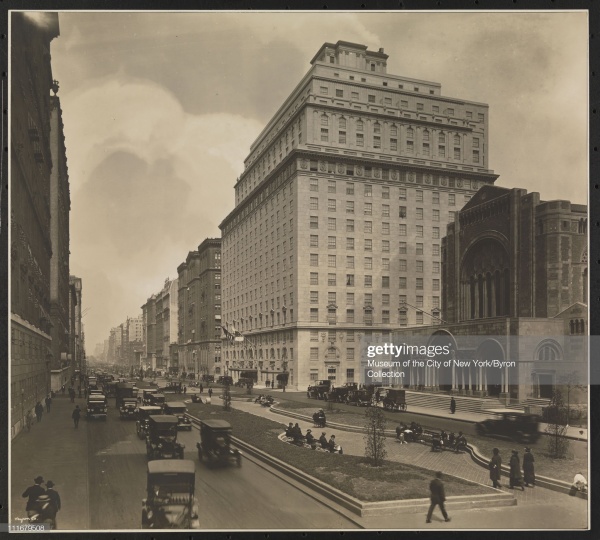
Foreign diplomats and members of the top rung of New York
society favor this elite residential hotel. Completed in
1921, it opened its doors to only those of political and
social influence.
- The 17th Floor
- The 17th floor of the Ambassador Hotel belongs entirely to
- Cornelia Van Hofwegen and her personal attendants and family
- favorites. While the Van Hofwegen family has a number of
- homes and estates both within New York City and throughout
- New York State, the 17th floor of the Ambassador Hotel the
- personal domain of Cornelia and from which her will is manifest
- throughout her family directly and the City more or less indirectly.
- Cornelia Van Hofwegen -- Senescent Dowager of the Van Hofwegen Family
- Laird Van Hofwegen -- Oldest of Cornelia's favorites (25yrs old)
- Henrietta Van Hofwegen -- Eighteen and fresh from finishing school in France (18yrs old)
- Judd Van Hofwegen -- An obese and precocious teenage boy. (13yrs old)
- Gust Van Hofwegen (Gus) -- Six-year-oid scion of the Van Hofwegen Family fortune
- Dirk Drees -- Man servant to the Van Hofwegen family (10 years)
- Leo Abraham -- Senior partner of Abraham, Martell & Suggit at Law
- Maynard Welch -- Personal bodyguard to Cornelia Van Hofwegen
MANHATTAN: MIDTOWN
Hippodrome {East 43 St., No.51}
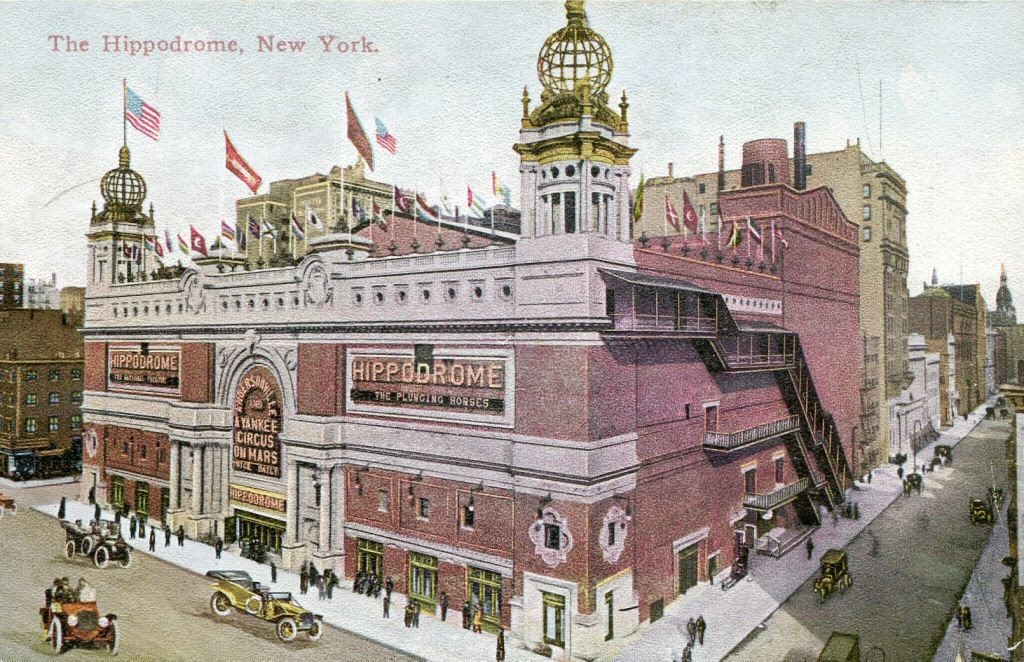
The Hippodrome was the heavy weight of the
theater district until it went down for the count
to the silver screen in 1928. It was demolished in
1939. In the twenties, it is the Coney Island of
Manhattan with outrageous water shows, prize-
fights, chorus lines, circuses, vaudeville and
nearly every species of entertainer performing
under its roof. Constructed in 1905 with the
capacity to seat 5200 people, the Hippodrome
always had a spectacle for all to see. It is the
location where Harry Houdini performed many of
his amazing shows.
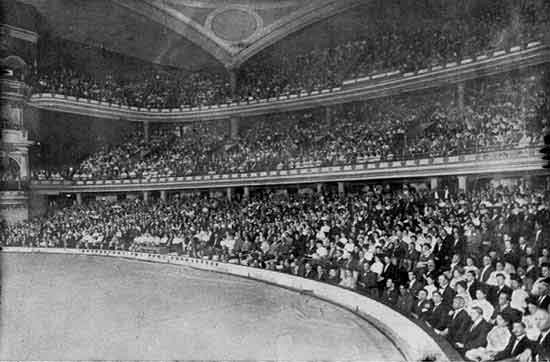

A broad swath of New York society frequents
this location. Politics, graft, intrigue and any
number of shady dealings can be found in the
Hippodrome.
https://nyc-architecture.com/GON/GON027.htm
http://www.nycago.org/Organs/NYC/html/HippodromeTheatre.html
MANHATTAN: DOWNTOWN
THE OUTER BOROUGHS
History
“The land is the finest for cultivation that I ever in my life set foot upon .... Were our own industrious farmers to settle here, they would soon transform this wilderness into a Paradise where no man need ever go hungry . . . . Never have I beheld such a rich and pleasant land.”
- Henry Hudson
The Arrival of the Half Moon
Written documentation of the history of New York City began with the first European visit to the area by Giovanni da Verrazzano, in command of the French ship La Dauphine, when he visited the region in 1524. It is believed he sailed into Upper New York Bay, where he encountered native Lenape, returned through The Narrows, where he anchored the night of April 17, and then left to continue his voyage. He named the area of present-day New York City Nouvelle-Angoulême (New Angoulême) in honor of Francis I, King of France and Count of Angoulême.
European settlement began on September 3, 1609, when the Englishman Henry Hudson, in the employ of the Dutch East India Company, sailed the Half Moon (Dutch: Halve Maen) through The Narrows into Upper New York Bay. Like Christopher Columbus, Hudson was looking for a westerly passage to Asia. He never found one, but he did take note of the abundant beaver population. Beaver pelts were in fashion in Europe, fueling a lucrative business. Hudson's report on the regional beaver population served as the impetus for the founding of Dutch trading colonies in the New World, among them New Amsterdam, which would become New York City. The beaver's importance in New York City history is reflected by its use on the city's official seal.
The Dutch West Indies Company transported African slaves to the post as trading laborers. By the late 17th century, 40 percent of the settlement were African slaves. They helped build the fort and stockade, and some gained freedom under the Dutch. After the English took over the colony and city they called New York in 1664, they continued to import slaves from Africa and the Caribbean. In 1703, 42 percent of the New York households had slaves; they served as domestic servants and laborers but also became involved in skilled trades, shipping and other fields. By the 1770s slaves made up less than 25 percent of the city's population. The city's strategic location and status as a major seaport made it the prime target for British seizure in 1776. General George Washington lost a series of battles from which he narrowly escaped, and the British Army controlled the New York City until late 1783. The city briefly served as the new nation's capital in 1789–90. The opening of the Erie Canal gave excellent steamboat connections with upstate New York and the Great Lakes, along with coastal traffic to lower New England, making the city the preeminent port on the Atlantic Ocean. The arrival of rail connections to the north and west in the 1840s and 1850s strengthened its central role,
Beginning in the mid-19th century, waves of new immigrants arrived from Europe, dramatically changing the composition of the city and serving as workers in the expanding industries. Modern New York City traces its development to the consolidation of the five boroughs in 1898 and an economic and building boom following the Great Depression and World War II. Throughout its history, New York City has served as a main port of entry for many immigrants, and its cultural and economic influence has made it one of the most important urban areas in the United States and the world.
Ancient Mutineers
- Aart Van Hofwegen --
- Anbrose Mogens --
- Marcel Vander Klei --
- Franz Van Hals --
Modern Heirs
- Anbrose Mogens VII --
- Eugene Vander Klei --
- Gust Van Hofwegen --
Population
- Year Pop. ±%
- 1900 3,437,202 +37.1%
- 1910 4,766,883 +38.7%
- 1920 5,620,048 +17.9%
- 1930 6,930,446 +23.3%
Arenas
Attractions
Bars and Clubs
- Havana Madrid
- Stork Club
- Small's Paradise
- Connie's Inn
- Savoy Ballroom
- Eve's Hangout -- Gay & Lesbian Tearoom in Greenwich Village
Barbership
- Blades of Silver -- Italian Barbershop
Cemeteries
City Government
Crime & Punishment
History of the NYPD
Prior to the establishment of the NYPD, New York City's population of about 320,000 was served by a force consisting of 1 night watch, 100 city marshals, 31 constables, and 51 municipal police officers. On May 7, 1844, the New York State passed the Municipal Police Act, a law which authorized creation of a police force and abolished the night watch system. At the request of the New York City Common Council, Peter Cooper drew up a proposal to create a police force of 1,200 officers. John Watts de Peyster was an early advocate of implementing military style discipline and organization to the force.
However, because of a lengthy dispute between the Common Council and the Mayor of New York City regarding who would appoint the officers, the law was not put into effect until the following year. Under Mayor William Havemeyer, the city finally repealed their watch system and adopted the Municipal Police Act as an ordinance on May 23, 1845, creating the New York Police Department in fact rather than merely in legislative theory.
For the purposes of policing, the city was divided into three districts, with courts, magistrates, and clerks, and station houses. The NYPD was closely modeled after the Metropolitan Police Service in London, England which used a military-like organizational structure, with rank and order. A navy blue uniform was introduced after long debate in 1853.
In 1857, Republican Party reformers in the New York State capital of Albany created a new Metropolitan police force and abolished the Municipal police, as part of their effort to rein in the Democratic Party-controlled New York City government. The Metropolitan Police Bill consolidated the police in New York, Brooklyn, Staten Island, and Westchester County (which then included The Bronx), under a Governor of New York-appointed board of commissioners.
Unwilling to be abolished, Mayor Fernando Wood and the Municipals resisted for several months, during which time the city effectively had two police forces, the State-controlled Metropolitans, and the Municipals. The Metropolitans included 300 policemen and 7 captains who left the Municipal police but was primarily made up of raw recruits with little or no training. The Municipals were controlled directly by Wood and including 800 policemen and 15 captains who stayed. The division between the forces was ethnically determined, with immigrants largely staying with the Municipals, and those of Anglo-Dutch heritage going to the Metropolitans.
Chaos ensued. Criminals had a high old time. Arrested by one force, they were rescued by the other. Rival cops tussled over possession of station houses. The opera buffa climax came in mid-June when [a] Metropolitan police captain ... attempted to deliver a warrant for the mayor's arrest, only to be tossed out by a group of Municipals. Armed with a second warrant, a much larger force of Metropolitans marched against City Hall. Awaiting them were a massed body of Municipals, supplemented by a large crowd ... Together, the mayor's supporters began clubbing and punching the outnumbered Metropolitans away from the seat of government. ...The Metropolitans gained the day after the [State-controlled] Seventh Regiment came to its rescue, and the warrant was served on Wood. This setback for the mayor was followed by another: on July 2 the Court of Appeals ruled in favor of the state law. Wood knuckled under and disbanded the Municipals late in the afternoon of July 3, leaving the Metropolitans in possession of the field.
Unfortunately, the untested Metropolitans failed to prevent rioting in the city the next day, Independence Day (July 4), and had to be rescued by the Bowery Boys, a nativist gang, when the Irish-immigrant gang the Dead Rabbits attacked the "Mets". Barricades were erected and the battle went on for hours, the worst rioting in the city since 1849. The next Sunday, peace was maintained by the State Militia, but a week later, on July 12, German-immigrants in Little Germany rioted when the Metropolitans attempted to enforce the new reform liquor laws and close down saloons. A blacksmith was killed in the skirmish, and the next day, ten thousand marched up Broadway with a banner proclaiming Opfer der Metropolitan-Polizei ("Victim of the Metropolitan Police").
Throughout the years, the NYPD has been involved with a number of riots in New York City. In July 1863, the New York State Militias were aiding Union Army troops in Pennsylvania, when the 1863 New York Draft Riots broke out. Their absence left it to the police — who were then outnumbered — to quell the riots. The Tompkins Square Riot occurred on January 13, 1874 when police crushed a demonstration involving thousands of unemployed in Tompkins Square Park.
Newspapers, including The New York Times, covered numerous cases of police brutality during the latter part of the 19th century. Cases often involved officers using clubs to beat suspects and persons who were drunk or rowdy, posed a challenge to officers' authority, or refused to move along down the street. Most cases of police brutality occurred in poor immigrant neighborhoods, including Five Points, the Lower East Side, and Tenderloin.
Beginning in the 1870s, politics and corruption of Tammany Hall, a political machine supported by Irish immigrants infiltrated the NYPD, which was used as political tool, with positions awarded by politicians to loyalists. Many officers and leaders in the police department took bribes from local businesses, overlooking things like illegal liquor sales. Police also served political purposes such as manning polling places, where they would turn a blind eye to ballot box stuffing and other acts of fraud.
The Lexow Committee was established in 1894 to investigate corruption in the police department. The committee made reform recommendations, including the suggestion that the police department adopt a civil service system. Corruption investigations have been a regular feature of the NYPD, including the Knapp Commission of the 1970s, and the Mollen Commission of the 1990s.
In 1895, Theodore Roosevelt became President of the NYPD Police Commission. Under his leadership, many reforms were instituted in the NYPD.
On 1 January 1898, the city expanded to include Brooklyn. The department absorbed eighteen existing police departments, requiring more modern organization and communication as it now protected 320 square miles and over three million residents.
20th Century NYPD
Around the turn of the century, the NYPD began to professionalize under leadership of then President of the Police Commission, Theodore Roosevelt. With innovations in science and technology, the police force were able to establish new units, such as the Bomb Squad in 1905, Motorcycle Squad in 1911, Automobile Squad in 1919, Emergency Service Unit in 1926, Aviation Unit in 1929 as well as the Radio Motor Patrol (RMP) in 1932. The department was also among the earliest to implement fingerprinting techniques and mug shots. In 1919, the department adopted its own flag.
In 1911, the department hired Samuel (Jesse) Battle as its first black officer. He went on to become the first black sergeant and lieutenant and retired after a thirty-year career.
In the 1910s, the NYPD began to deploy female matrons, who had entered precincts at the close of the previous century, to conduct undercover investigations. Their duties included investigating irregular medical practitioners, confidence tricksters, fortune tellers, and abortionists. In October 1916, Margaret Whitehurst assigned to detective work in Brooklyn led an undercover investigation of Margaret Sanger's Brownsville birth control clinic. Some ambitious matrons also conducted plainclothes surveillance of public spaces, such as dance halls and bars. Those formally appointed as policewomen and patrolwomen during and after the First World War continued and expanded upon these policing tasks. Notably, policewomen conducted the 1926 raid of the gay and lesbian tearoom, Eve's Hangout, in Greenwich Village and arrested its proprietor Eve Adams.
In 1896 Commissioner Roosevelt authorized the purchase of a standard issued revolver for the NYPD. It was the Colt New Police Revolver in .32 Long Colt caliber. He also instituted required firearms training including pistol practice and qualification for officers. In 1907 the Colt Police Positive revolver in .38 caliber was adopted by the department. In May 1926 the NYPD adopted the .38 Special cartridge as the standard issue ammunition for the department and started issuing its officers the Smith & Wesson Model 10 revolver and the Colt Official Police revolver.
Ladies of the NYPD
Cops of Color
Private Dicks
- Frank Heller -- Private Gumshoe & Public Dick
- Serenity Washington -- Heller's Secretary
- Frank Heller -- Private Gumshoe & Public Dick
Criminals
- Axel Kohl -- German criminal captain
- Antoon Kool --
- Sully Branagan -- A misguided ruffian
- [[]] --
- Utz Jäger -- Riker's Island Inmate & Escapee
https://en.wikipedia.org/wiki/History_of_the_New_York_City_Police_Department
Citizens of the City
- John Purroy Mitchel -- Mayor during the Meissner Murder-Suicide (January 1, 1914 – December 31, 1917)
- John Francis Hylan -- Mayor of New York (1917 - ?)
- Arthur H. Woods -- Police Commissioner during the Meissner Murder-Suicide (April 8, 1914 – January 1, 1918)
- Frederick Hamilton Bugher -- Former Police Commissioner (January 1, 1918 – January 23, 1918)
- Richard Edward Enright -- Commissioner of Police (January 23, 1918 – ?)
- Otto Kraus (Titus) -- Captain and former Detective in charge of the Meissner Murder-Suicide
- Alan Renault -- Crime Scene Photographer during the Meissner Murder-Suicide (Retired)
- Kaydenn Mallon -- Crime Scene Photographer during the Meissner Murder-Suicide (Active)
- Cyryl Kędzierski -- A raw recruit during the Meissner Murder-Suicide, six years later a detective.
- Fearghas Colm Grady -- Warden
- Mahir Ismet Mehmedovic -- Psychiatrist
---
- Erasmus Driggs -- Chief Editor of the New York Weekly Messenger
- Jean Robbins -- Secretary to Mr. Driggs-
- Sydney Silver -- star journalist
---
- Cornelia Van Hofwegen (Anouska) -- Dowager of an old Dutch New York family
- Gust Van Hofwegen (Gus) -- Scion of an old New York family
- Dirk Drees -- Man servant to the Van Hofwegen family (10 years)
- Abilene Anson (Star) -- Attorney at Law
---
- Bartolo Salvatore Neroni -- Rival private investigator
- Matthäus Meinhard Meissner -- Father of Aaron Meissner and husband of Klaudia Mona Heller Meissner
- The Tall-Man -- A Strange circus performer who dresses in somber suits of black and white
- Father Wouter Merx -- Utz JAGER'S CONFESSOR
- Theodore Hext --
- Jan Cloet -- Professor
- Brittney Lyndia Hudson --
- Axel Kohl -- German criminal captain
- Wendell Wadsworth -- Antiquarian
- Sylvania Astrider -- Archeology Student
Communications
Current Events
Fortifications
Galleries
Holy Ground
Hospitals
Hotels & Flop Houses
Uptown
- Manhattan Towers
- Midtown Hotel
- Emerson Hotel
Midtown
- Blackstone
- Gotham
- Hampshire House
- Barclay's Hotel
- The Capital
- The Vanderbilt
- The Pennsylvania
- The Imperial
Downtown
- The Lafayette
- The Ledonia
- The Arlington
Investigators
Landmarks
Mass Media
Newspapers
- New York Weekly Messenger
Monuments
Museums
Parks
Private Residences
Restaurants
Ruins
Schools
Secret Societies
Shopping
Theaters
Transportation
Trains
- Pennsylvania Station (1910–1963) - Often abbreviated to Penn Station, was a historic railroad station in New York City, named for the Pennsylvania Railroad (PRR), its builder and original tenant. The station occupied an 8-acre (3.2 ha) plot bounded by Seventh and Eighth Avenues and 31st and 33rd Streets in Midtown Manhattan. As the terminal shared its name with several stations in other cities, it was sometimes called New York Pennsylvania Station.
- Grand Central Terminal (GCT; also referred to as Grand Central Station or simply as Grand Central) - is a commuter rail terminal located at 42nd Street and Park Avenue in Midtown Manhattan, New York City. Grand Central is the southern terminus of the Metro-North Railroad's Harlem, Hudson and New Haven Lines, serving the northern parts of the New York metropolitan area. It also contains a connection to the New York City Subway at Grand Central–42nd Street station. The terminal is the second-busiest train station in North America, after New York Penn Station.
Unfathomable Horrors
- Sylurus
Errata
Websites
https://en.wikipedia.org/wiki/New_York_City_Police_Commissioner
